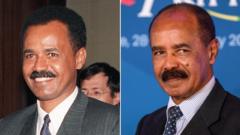Eritreas have long endured a complex political landscape marked by dashed hopes and persistent challenges. As Isaias Afwerki recently celebrated over 32 years in power, the weight of stagnation and repression looms large. Initially revered as a symbol of hope and progress following Eritrea's independence from Ethiopia in 1991, Isaias's early promise of reform and democratization has devolved into an unyielding authoritarian grip.
His presence now remains secluded at a rural residence near the capital, Asmara, where he rarely interacts with political bodies, reportedly not having convened his cabinet since 2018. Once an emblem of hope for many, Isaias has not held a single election during his tenure and appears unlikely to initiate one anytime soon.
In the 1990s, Isaias was celebrated as a new breed of African leader intent on steering Eritrea away from the historical patterns of autocracy. He articulated aspirations for democratic governance and a commitment to rebuilding the nation, garnering admiration from both civilians and international observers. However, the hope for a democratic transition was cruelly stifled by outbreak of war with Ethiopia in 1998 over border disputes.
The disappointment intensified in 2001, when a cohort of reformist government officials - dubbed the G-15 - highlighted Isaias's increasing authoritarianism through their calls for reform and compliance with the nation's ratified constitution. In a shocking series of events, the government quelled dissent by arresting the G-15 members and silencing independent media, effectively extinguishing the flickering hopes of political pluralism in Eritrea.
The repressive measures implemented by Isaias included the disbandment of the transitional assembly and a crackdown on dissenting voices, leading to international isolation for Eritrea. The long-neglected economy further spiraled into decline, with assessments indicating severe structural limitations and vast underdevelopment. Despite recognizing the dismal state of the economy, Isaias remains steadfast in rejecting foreign humanitarian assistance, asserting a mantra of self-reliance.
In contemporary Eritrea, pervasive human rights violations mar the lives of many, particularly youth entangled in indefinite national service. The bleak trajectory has spurred an exodus of Eritreans seeking freedom, making them one of the most frequent national groups seeking asylum in the UK.
As his presidency stretches into his late 70s without an apparent succession plan, concerns rise about the future of Eritrea post-Isaias. Observers express apprehension about potential instability, haunted by the absence of viable opposition structures and the pervasive control exercised by Isaias.
Though occasional shifts in rhetoric hint at potential constitutional reforms, the reality reflects a deeply entrenched autocracy. As Isaias remains ensconced in power, hope for transformative change wades into uncertainty amidst a backdrop of enduring despair for the Eritrean populace. Anxious hearts continue to await the dawn of a new era, while Isaias stands firm at the helm of a nation longing for liberation.
His presence now remains secluded at a rural residence near the capital, Asmara, where he rarely interacts with political bodies, reportedly not having convened his cabinet since 2018. Once an emblem of hope for many, Isaias has not held a single election during his tenure and appears unlikely to initiate one anytime soon.
In the 1990s, Isaias was celebrated as a new breed of African leader intent on steering Eritrea away from the historical patterns of autocracy. He articulated aspirations for democratic governance and a commitment to rebuilding the nation, garnering admiration from both civilians and international observers. However, the hope for a democratic transition was cruelly stifled by outbreak of war with Ethiopia in 1998 over border disputes.
The disappointment intensified in 2001, when a cohort of reformist government officials - dubbed the G-15 - highlighted Isaias's increasing authoritarianism through their calls for reform and compliance with the nation's ratified constitution. In a shocking series of events, the government quelled dissent by arresting the G-15 members and silencing independent media, effectively extinguishing the flickering hopes of political pluralism in Eritrea.
The repressive measures implemented by Isaias included the disbandment of the transitional assembly and a crackdown on dissenting voices, leading to international isolation for Eritrea. The long-neglected economy further spiraled into decline, with assessments indicating severe structural limitations and vast underdevelopment. Despite recognizing the dismal state of the economy, Isaias remains steadfast in rejecting foreign humanitarian assistance, asserting a mantra of self-reliance.
In contemporary Eritrea, pervasive human rights violations mar the lives of many, particularly youth entangled in indefinite national service. The bleak trajectory has spurred an exodus of Eritreans seeking freedom, making them one of the most frequent national groups seeking asylum in the UK.
As his presidency stretches into his late 70s without an apparent succession plan, concerns rise about the future of Eritrea post-Isaias. Observers express apprehension about potential instability, haunted by the absence of viable opposition structures and the pervasive control exercised by Isaias.
Though occasional shifts in rhetoric hint at potential constitutional reforms, the reality reflects a deeply entrenched autocracy. As Isaias remains ensconced in power, hope for transformative change wades into uncertainty amidst a backdrop of enduring despair for the Eritrean populace. Anxious hearts continue to await the dawn of a new era, while Isaias stands firm at the helm of a nation longing for liberation.



















